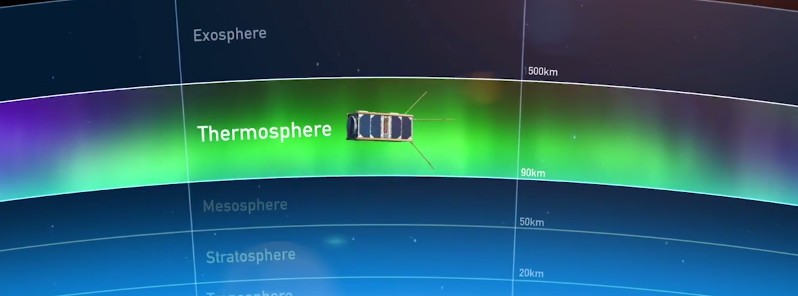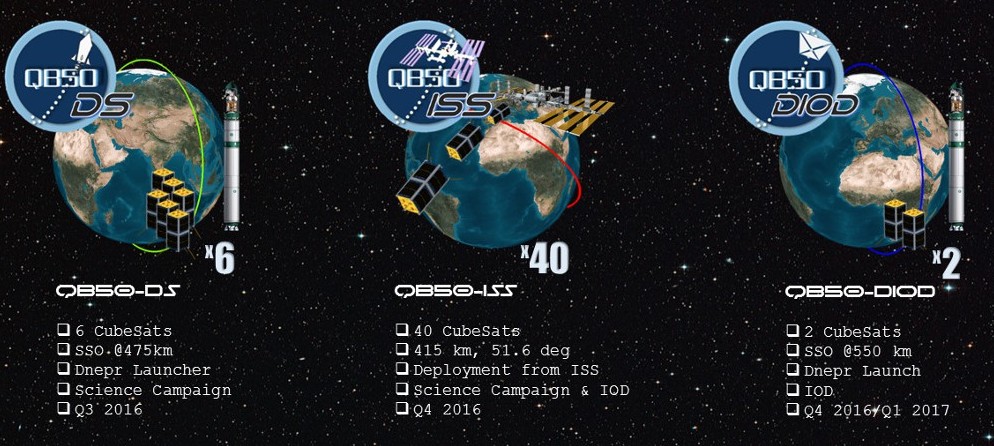A flotilla of CubeSats will be launched from the ISS to study Earth’s thermosphere

A flotilla of 50 CubeSats, miniaturized satellites weighing an average of 2 kg (4.4 lb) each, will be launched from the ground and the International Space Station in the European-led QB50 mission to explore the little-understood region above Earth known as the thermosphere. The mission, expected to start launching first CubeSats in late 2016, will focus on the lower thermosphere, between 200 and 380 km (124 and 236 miles) above Earth, a region that helps shield Earth from cosmic and solar radiation and plays a vital role in communications and weather formation.
"This region is poorly understood and hard to measure," said Andrew Dempster, Director of Australian Centre for Space Engineering Research (ACSER) at UNSW. "And yet, it's the interface between our planet and space. It's where much of the ultraviolet and X-ray radiation from the Sun collides with the Earth and generates auroras and potential hazards that can affect power grids and communications."
Space agencies are not pursuing a multi-spacecraft network for in-situ measurements in the lower thermosphere because the cost of a network of 50 satellites built to industrial standards would be extremely high and not justifiable given the limited orbital lifetime. A network of satellites for in-situ measurements in the lower thermosphere can only be realized by using very low-cost satellites, and CubeSats are the only realistic option.
One of the other objectives of the QB50 mission, led by Belgium's Von Karman Institute for Fluid Dynamics, is to achieve a sustained and affordable access to space for small-scale research space missions and planetary exploration. The third objective of the QB50 Project is to serve as a platform for technology demonstration.
All 50 satellites have been built over the past couple of years by 48 universities and research institutes from 28 nations. The mission will make use of three different launch campaigns to complete the orbital injection of all the CubeSats:
- 6 CubeSats launched on a “Dnepr Science Flight”, QB50-DS (Launch Q3 2016)
- 40 CubeSats deployed from the ISS, QB50-ISS (Launch Q4 2016)
- 2 In-Orbit Demonstration (IOD) CubeSats launched on a second Dnepr, the “Dnepr IOD Flight”, QB50-DIOD (Launch Q4 2016 / Q1 2017)

Image credit: QB50
40 QB50 CubeSats will be launched to the International Space Station in December by an Orbital ATK Antares rocket from Wallops Island, Virginia, inside a Cygnus cargo freighter. The CubeSats will be deployed from the ISS between a month or so after arrival, and drift down from the ISS's orbit of 380 km toward the target region.
"This is the most extensive exploration of the lower thermosphere ever, collecting measurements in the kind of detail never before tried," said Elias Aboutanios, project leader of UNSW-Ec0 and a senior lecturer at UNSW. "The satellites will operate for 3 – 9 months – and may last up to a year – orbiting this little-studied region of space, before their orbits decay and they re-enter the atmosphere and burn up."

Video courtesy UNSW
Each CubeSat also carries other instruments with its own engineering and scientific goals. UNSW-Ec0, for example, has three other experiments: a robust computer chip designed to avoid crashing in the harsh radiation of space, as some satellites and space probes are forced to do when hit by cosmic rays; a space-borne GPS to allow satellites to cluster together in swarms; and test a super-reliable computer microkernel in the harsh radiation of space.
In addition, UNSW-Ec0's chassis is made entirely from 3D-printed thermoplastic, itself an experiment to test the reliability of using 3D-printing to manufacture satellites, making them cheaper.
Featured image credit: UNSW

Commenting rules and guidelines
We value the thoughts and opinions of our readers and welcome healthy discussions on our website. In order to maintain a respectful and positive community, we ask that all commenters follow these rules.